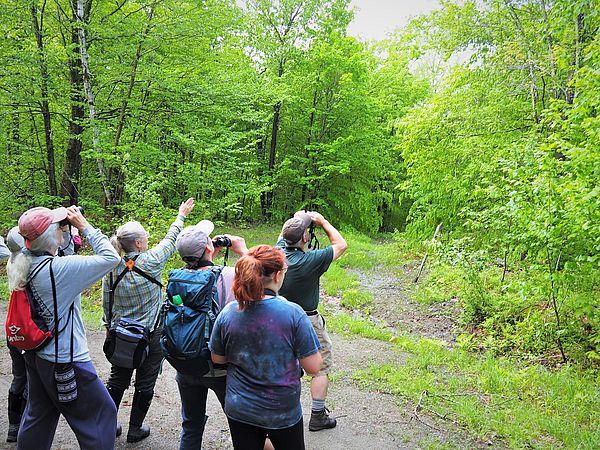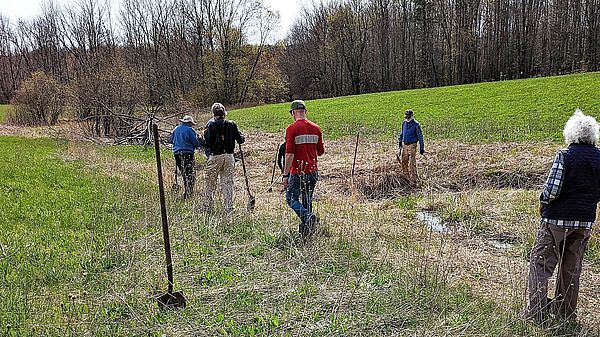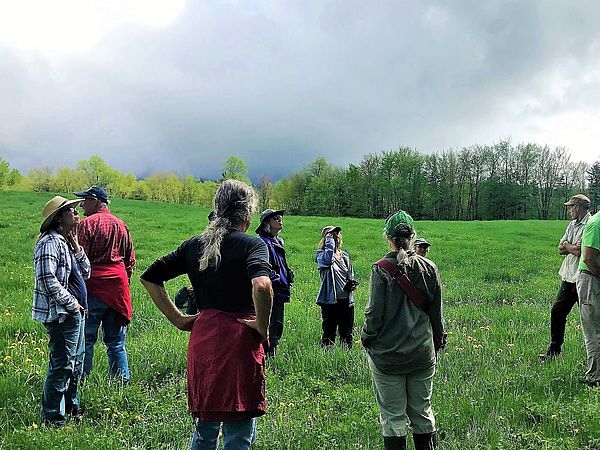May was a busy month for Cold Hollow to Canada. We helped landowners plant 350 trees to benefit forest resilience goals. We met with leaders from Vermont Youth Conservation Corps and Audubon Vermont on a Belvidere sugarbush, to plan the logistics of a summer youth crew helping with a bird-friendly maple forest stewardship project. We met with all four of our Woodlots groups, walking private forest land while discussing a variety of stewardship techniques and natural history topics. One event included a guest from Audubon Vermont, to review the Forest Bird Habitat Assessments conducted for every member of the group. We held a public bird walk with Bird Diva Bridget Butler.
And this isn't even a complete list. Like I said, May was a busy month at CHC!
In the midst of the hustle and bustle, it’s easy to get caught up in the action, finishing one activity and moving on to the next, checking each off a list and considering it “accomplished.” But CHC’s last event–that bird walk with Bridget Butler–reminds me to slow down. Bridget promotes a technique she calls “slow birding.” The idea is this: Instead of birding with the purpose of seeing and naming as many birds as possible, slow birding is about spending a bit of time with each, understanding why you’re seeing what you’re seeing, and reflecting. Where is the bird, and why is it there? What is it doing? Instead of needing to know the calls of every warbler in the woods for the purposes of a checklist, Bridget encourages watchers to choose one or two new birds a season, or perhaps to pick a place (the backyard?) and get to know the birds of that location in a personal way. It feels less overwhelming, and the pressure to always find more dissolves into a deeper appreciation for the birds present.
Admittedly, there were a lot of birds out on our chosen bird walk morning in May, and the human attention span is always intrigued by what’s new and different. While we didn’t spend a long time on each bird, Bridget has a lovely way of interacting in a personable way with the birds she watches. She asks them questions. She praises them, just a bit. After spending considerable time watching a mourning warbler (a new one for me!), Bridget thanked the bird for its time with us before moving on.
On my drive home, I realized I could use more slow birding in my life… and not just with birds. The same technique, I decided, could really be applied to a variety of topics.
And so, with slow birding in mind, I’d like to go through that checklist list of May activities at CHC again, this time remembering to stop for just long enough to describe the “habitat” in which each resides and think about the food sources (aka funding) that allow each program to survive.
I’ll start by simply saying that grants are the primary food source for the grand majority of CHC’s programs. However, we also rely heavily on individual giving, so we extend a huge thank you to all of you who donate to CHC!
Perhaps the best place to begin is Bridget’s bird walk itself. This walk is nested (tee-hee) in an outreach series focused in the southern part of our region, specifically in the towns of Waterville and Belvidere. While these towns have always been a part of the CHC focal area, we had to acknowledge a few years ago that there has been a bit of a gap in our activities in these communities. Thanks to grants from the Davis Foundation and the Windham Foundation, we are making up for lost time, and Bridget’s walk is the third in a series of four events in these communities. All have been well-attended, and in fact we’ve been downright floored by the interest in some of these programs by those in the immediate community! The final event–an “Art In Nature” workshop to take place this summer (stay tuned!) will be followed by a set of community conversations in which we aim to learn from those closely tied to the two towns what they would like to see for the future. Because CHC prides itself on our community-led approach to stewardship and conservation, getting to know the community better is a crucial early step in accomplishing our goals. Thank you to the Davis and Windham Foundations for allowing these projects to happen, and thank you to the participants in the events themselves! It’s been wonderful to get to know you, and we look forward to more!
Most of the other May activities have involved our Woodlots Program in one way or another. This program convenes peer networks of neighboring owners of forest land. Each group meets 3-4 times a year over topics of forest stewardship or resilience. When possible and/or needed, we bring in speakers to introduce a broader range of topics, and we strive to provide both technical and financial assistance to each group, such as with the recent tree planting event, in which the trees themselves were paid for through a Regional Conservation Partnership Program grant we have with the Natural Resources Conservation Service, and we recruited volunteers to help with the planting process. The Woodlots Program has been funded primarily through grants with two entities: US Forest Service’s Landscape Scale Restoration Grant, and the High Meadows Fund. The Forest Service grant drew to a close in the Fall of 2021, and you can read more about the program’s successes in an article in the Forest Service publication Inside the Forest Service, which came out earlier this month. The High Meadows Fund has also been an incredible ally for our Woodlots Program, supporting CHC not only financially but by placing CHC into a cohort of other organizations in Vermont with similar Forest Health and Integrity goals. Together, this cohort is looking for common solutions to advance forest health throughout the state. In 2022, High Meadows dissolved into a new Daybreak Fund with the Vermont Community Foundation, with largely the same goals. Thank you to our old friends at High Meadows and our new ones at Daybreak, and our partners in the US Forest Service! And thank you, too, to all of the incredible landowners involved in the Woodlots Programs. These individuals collectively steward >15,000 acres of forest in the CHC region, and they are doing so with thoughtful consideration of wildlife, forest health, and climate resilience.
Speaking of wildlife, forest health, and climate resilience, perhaps this is a good time to mention some of the partner organizations that help with these aspects of the Woodlots Program. For example, the Forest Bird Habitat Assessments conducted by Audubon Vermont mentioned earlier came at no cost to either CHC or the landowners who received them. Audubon itself received grant funding to complete these assessments, and the organization’s talented staff have now walked through the forests of nearly all Woodlots landowners, identifying ways each property could enhance the bird habitat available. Audubon was also responsible for initiating a 3-way pilot partnership between CHC, Audubon, and the Vermont Youth Conservation Corps (VYCC), in which CHC identifies projects in need, Audubon provides bird habitat expertise, and VYCC brings a crew to the woods to accomplish the management itself, while training youth in a much-needed field. Because VYCC specializes in non-commercial or pre-commercial management, they can accomplish projects otherwise difficult for landowners to fund and that are often unattractive to forest professionals. At the same time, these projects produce benefits to wildlife habitat, climate resilience, or overall forest health. Thank you, Audubon Vermont and VYCC!
Climate resilience is another aspect of the Woodlots Program–with another funder and another partnership. In this case, the Open Space Institute and Land Trust Alliance have joined forces to fund projects that contribute to climate resilience–and they have selected ours! This summer, participants in our newest Woodlots groups will be receiving Climate Change Analyses for their properties. In collaboration with the VT Department of Forests, Parks, and Recreation, CHC staff will be going through forest management plans to identify strategies that aid with climate resistance, resilience, or transition within our local forests. Results will be shared with landowners, and each group will be able to discuss the diversity of strategies employed across the region, together understanding both what’s already being done and what additional strategies may be appropriate. Thank you, Open Space Institute and Land Trust Alliance!
I should probably stop there for now, lest this list becomes akin to an eye-glazing and overwhelming description of all the warblers in the northern forest. That said, I’ll note that even when Bridget goes “slow birding,” she maintains a checklist of what she sees. After all, checklists can be helpful for knowing what’s present and how it changes over time, and we can refer to them on future trips to the same spot. On our May walk, we noted a black-and-white warbler in the distance, for example, that we simply never had time to go back and check out. It’s on the list… but it will be a subject for another day. In the meantime, CHC’s current “birding checklist” of grants includes:
- Cornell Lab of Ornithology/Highstead Foundation (If you’re inspired to come to one of Bridget Butler’s walks, she’s coming back to the CHC region in July because of this grant! See more on our website.)
- Upper Missisquoi and Trout Rivers Wild & Scenic River Community Grant
- VT Fish & Wildlife Department/ Vermont Watershed Grant
- Davis Foundation
- Windham Foundation
- Open Space Institute/Land Trust Alliance
- Natural Resources Conservation Service (RCPP)
- High Meadows/Daybreak Fund
- …and since we’ve recently applied for several more, we’re hoping to report an even longer list soon!
Lest I forget, I’ll add with one last bit of gratitude. Thank you, Bridget, for reminding me to slow down and show gratitude before moving on to the next great birding spot!


